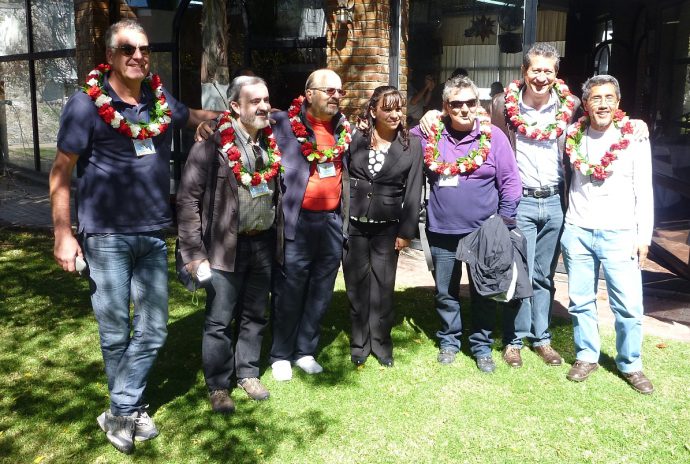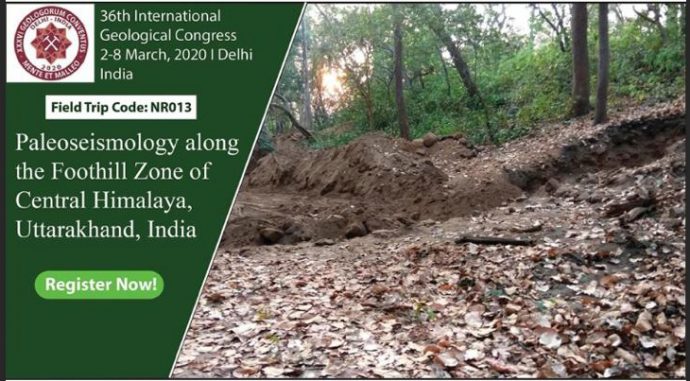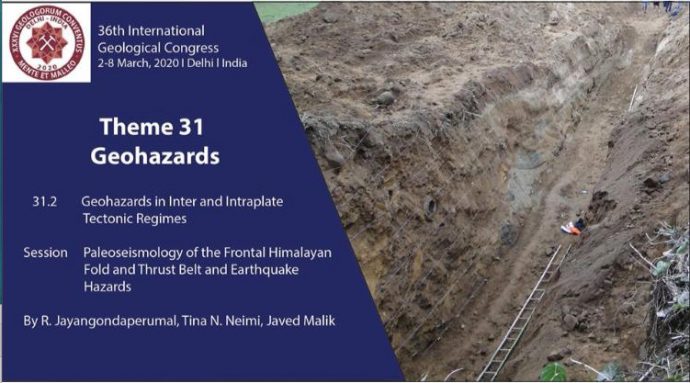The INQUA Summer School on Active Tectonics and Tectonic Geomorphology was held in Prague from 24-27 September, 2019. This summer school was run by INQUA‘s IFG EGSHaz as part of the TERPRO commission. The event was hosted by the Institute of Rock Structure and Mechanics, Academy of Sciences of the Czech Republic, Dpt. Neotectonics and Thermochronology. Main organizer was IFG co-leader Petra Štěpančíková. We would also like to thank MSc. Jakub Stemberk, Monika Hladká, Jana Šreinová, the deputy director Dr. Filip Hartvich, and all the staff involved for their professionalism and warm hospitality. Overall, 50 participants and 14 lecturers from 25 countries participated in the summer school.
more-
Christoph GrütznerCC BY-SA 3.0
This was the INQUA Summer School on Active Tectonics and Tectonic Geomorphology in Prague
-
We mourn the passing of Prof. Dr. Victor Hugo Garduño Monroy
2019-10-17 | in UncategorizedDear colleagues,
It is with great sadness that we received note from the passing of our dear colleague Victor Hugo Gorduño Monroy.
Victor was a close friend to many of us and an outstanding person in the Mexican scientific community. He authored a great number of publications on the geology of Mexico, on tectonics, volcanism, and hazards. His work did not only advance geosciences, but also had huge impact on society. He was tireless in helping to raise the awareness for disasters and to promote geoscience in the public. We will never forget his enthusiasm and his dedication in the field.
He had the leading role in geosciences at the Michoacan University of San Nicolás de Hidalgo and taught hundreds of students during his career.
Victor organized the first PATA days outside Europe in November 2012 in Morelia in commemoration of the 1912 Acambay Earthquake, which was an absolute pleasure and a great success.
Our thoughts are with his family and with everyone who worked closely with him.
The Michoacan University of San Nicolás de Hidalgo released the following letter of condolence:
El día de hoy sufrimos la pérdida de una de nuestras más sólidas columnas institucionales. Informamos con profunda tristeza que el Dr. Víctor Hugo Garduño Monroy falleció esta mañana y con él perdimos a nuestro Líder Académico y Fundador de la Maestría en Geociencias y Planificación del Territorio y del Instituto de Investigaciones en Ciencias de la Tierra. El Dr. Garduño fue un incansable investigador de la Geología de nuestro Estado y del Occidente de México. Formador profesional de centenares de estudiantes a nivel profesional y posgrado. Ganador de la Presea José María Morelos y Pavón y Primer Investigador en Obtener la Presea Vasco de Quiroga en nuestra querida Universidad Michoacana de San Nicolás de Hidalgo. Hoy se fue uno de los mejores investigadores de nuestra Universidad, de nuestro Estado y de nuestro País. Siempre será recordado por el cariño a su profesión, a sus estudiantes y compañeros. Descanse en Paz.

Victor (right) with his friends and colleagues during the 2012 PATA Days in Morelia, Mexico. -
Christoph GrütznerCC BY-SA 3.0
New papers on paleoseismology, earthquakes, and active tectonics (Oct 2019)
-
Landslides triggered by multiple earthquakes – a Matlab code
2019-09-25 | in Software and Applications, Uncategorized | one responseModerate to strong earthquakes commonly produce secondary effects (landslides, liquefaction, tsunamis), which worsen the impact of the seismic event, both during the emergency and recovery phases.
Landslides can be triggered by events of M above 5 or so, and stronger events can produce thousands of landslides. Landslide inventories were compiled for dozens of events and the relations between Mw and maximum distance or area affected by landslides have been analyzed (e.g., Keefer, 1984; Rodriguez et al., 1999). On the other hand, the total area affected by landslides is one of the metrics used to assign the ESI intensity (Environmental Seismic Intensity; Michetti et al., 2007).
more -
Masahiko OHKUBOCC BY 2.0
Hokudan 2020 International Symposium on Active Faulting, 13-17 January, Awaji, Japan
2019-09-16 | in UncategorizedThe Hokudan 2020 International Symposium on Active Faulting will take place from 13-17 January in Awaji City, Awaji Island, Japan. The symposium is held every five years. The 2020 event commemorates the 25th anniversary of the 1995 Kobe earthquake. All important information on this meeting is available here: https://home.hiroshima-u.ac.jp/kojiok/hokudan2020.html
This event is supported by INQUA – the International Union for Quaternary Research and its TERPRO commission. For more information, please contact Koji Okumura (kojiok@hiroshima-u.ac.jp) or Shinji Toda (toda@irides.tohoku.ac.jp).
Deadline for abstract submission is 1 December, 2019.
-
Paleoseismology field trip and theme session at the 36th International Geological Congress – IGC, Delhi
2019-09-06 | in UncategorizedDuring the 36th IGC in Delhi there will be a symposium on “31.2 Paleoseismology of the Frontal Himalayan Fold and Thrust Belt and Earthquake Hazards” in the Geohazards Theme 31. Abstract submission is free until 15th Sept. 2019 and open until 15th Oct. 2019.
There will also be a field trip “Paleoseismology along the Foothill Zone of Central Himalaya, Uttarakhand, India” from 25-29 Feb. 2020, Field Trip Code NR013.


-
aZora Films
Seismic crisis reveals the growth of a young fault system in the Alboran Sea
2019-09-05 | in Paper | 2 responsesPress note related to the publication of the manuscript “Earthquake crisis unveils the growth of an incipient continental fault system” in Nature Communications (DOI: 10.1038/s41467-019-11064-5).
An international team led by the Institut de Ciències del Mar (ICM-CSIC, Barcelona) demonstrate the growth of a young fault in the Alboran Sea, called the Al-Idrissi Fault System, source of the magnitude (Mw) 6.4 earthquake, which affected Al-Hoceima, Melilla and the south of the Iberian Peninsula in January 2016.
more -
Christoph GrütznerCC BY-SA 3.0
New papers on paleoseismology, earthquakes, and active tectonics (Sep 2019)
-
Christoph Grützner
SSA call for papers on Ridgecrest Earthquakes and historical seismograms
2019-08-14 | in PaperThe Seismological Society of America has currently three interesting calls for papers.
- BSSA Call for Papers: Special Issue on the 2019 Ridgecrest, California, Earthquake Sequence: https://www.seismosoc.org/bssa-call-for-papers/
- SRL Data Mine Focus Section: 2019 Ridgecrest earthquake sequence: https://www.seismosoc.org/publications/calls-papers/srl-call-for-papers/
- SRL Call for Papers: Historical Seismograms: Challenges and Successes in Preservation, Digitization, and (Re)Analysis: https://www.seismosoc.org/publications/srl/call-for-papers-historical-seismograms-challenges-and-successes-in-preservation-digitization-and-reanalysis/
-
Christoph GrütznerCC BY-SA 3.0
Postdoctoral Research Assistant in Active Tectonics, Uni Oxford
2019-08-12 | in JobsThe Department of Earth Sciences at the University of Oxford is currently recruiting a PDRA in Active Tectonics Research:
We seek to appoint a Postdoctoral Research Assistant to work closely with Professor Richard Walker as part of a broader consortium in the NERC-funded ‘Looking Into the Continents from Space’ project, whose principal aim is to provide insights into earthquake hazard and crustal deformation through the application of a range of remote-sensing, field-based, seismological, and modelling approaches. The post is co-funded by COMET, which is a world-leading centre for understanding tectonic and volcanic processes and hazards (comet.nerc.ac.uk). The PDRA will join a thriving group involved in remote-sensing and field-based research in the study of active faulting and natural hazards.
The post is based in the Department of Earth Sciences and will be overseen by Richard Walker, Barry Parsons and Philip England. The post will also involve close collaboration with scientists at the other partner institutions involved in COMET and LICS. The successful applicant will be responsible for the mapping and analysis of fault-based geomorphology using high-resolution satellite imagery and digital topography, supplemented with fieldwork in selected regions. The production of high-resolution digital topographic datasets through field-based, aerial, or satellite methods, forms an important component of the duties. They will also be expected to possess or to develop skills in measuring surface displacements through the matching of optical satellite imagery, and to support both tectonic and volcanic applications of high-resolution imagery and elevation data throughout COMETFind more information here: https://my.corehr.com/pls/uoxrecruit/erq_jobspec_version_4.display_form?p_company=10&p_internal_external=E&p_display_in_irish=N&p_process_type=&p_applicant_no=&p_form_profile_detail=&p_display_apply_ind=Y&p_refresh_search=Y&p_recruitment_id=142106
or at the department website: https://www.earth.ox.ac.uk/vacancies/.
Application deadline is 9 September 2019.
